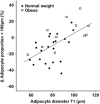Body fat mass and the proportion of very large adipocytes in pregnant women are associated with gestational insulin resistance
- PMID: 26563815
- PMCID: PMC4827013
- DOI: 10.1038/ijo.2015.232
Body fat mass and the proportion of very large adipocytes in pregnant women are associated with gestational insulin resistance
Abstract
Background/objectives: Pregnancy is accompanied by fat gain and insulin resistance. Changes in adipose tissue morphology and function during pregnancy and factors contributing to gestational insulin resistance are incompletely known. We sought to characterize adipose tissue in trimesters 1 and 3 (T1/T3) in normal weight (NW) and obese pregnant women, and identify adipose tissue-related factors associated with gestational insulin resistance.
Subjects/methods: Twenty-two NW and 11 obese women were recruited early in pregnancy for the Pregnancy Obesity Nutrition and Child Health study. Examinations and sampling of blood and abdominal adipose tissue were performed longitudinally in T1/T3 to determine fat mass (air-displacement plethysmography); insulin resistance (homeostasis model assessment of insulin resistance, HOMA-IR); size, number and lipolytic activity of adipocytes; and adipokine release and density of immune cells and blood vessels in adipose tissue.
Results: Fat mass and HOMA-IR increased similarly between T1 and T3 in the groups; all remained normoglycemic. Adipocyte size increased in NW women. Adipocyte number was not influenced, but proportions of small and large adipocytes changed oppositely in the groups. Lipolytic activity and circulating adipocyte fatty acid-binding protein increased in both groups. Adiponectin release was reduced in NW women. Fat mass and the proportion of very large adipocytes were most strongly associated with T3 HOMA-IR by multivariable linear regression (R(2)=0.751, P<0.001).
Conclusions: During pregnancy, adipose tissue morphology and function change comprehensively. NW women accumulated fat in existing adipocytes, accompanied by reduced adiponectin release. In comparison with the NW group, obese women had signs of adipocyte recruitment and maintained adiponectin levels. Body fat and large adipocytes may contribute significantly to gestational insulin resistance.
Figures


References
-
- Nolan CJ, Damm P, Prentki M. Type 2 diabetes across generations: from pathophysiology to prevention and management. Lancet 2011; 378: 169–181. - PubMed
-
- Butte NF. Carbohydrate and lipid metabolism in pregnancy: normal compared with gestational diabetes mellitus. Am J Clin Nutr 2000; 71: 1256S–1261S. - PubMed
-
- Newbern D, Freemark M. Placental hormones and the control of maternal metabolism and fetal growth. Curr Opin Endocrinol Diabetes Obes 2011; 18: 409–416. - PubMed
-
- Lacroix M, Kina E, Hivert MF. Maternal/fetal determinants of insulin resistance in women during pregnancy and in offspring over life. Curr Diab Rep 2013; 13: 238–244. - PubMed
-
- Catalano PM, Roman-Drago NM, Amini SB, Sims EA. Longitudinal changes in body composition and energy balance in lean women with normal and abnormal glucose tolerance during pregnancy. Am J Obstet Gynecol 1998; 179: 156–165. - PubMed
MeSH terms
Substances
LinkOut - more resources
Full Text Sources
Other Literature Sources
Medical
Research Materials
Miscellaneous

